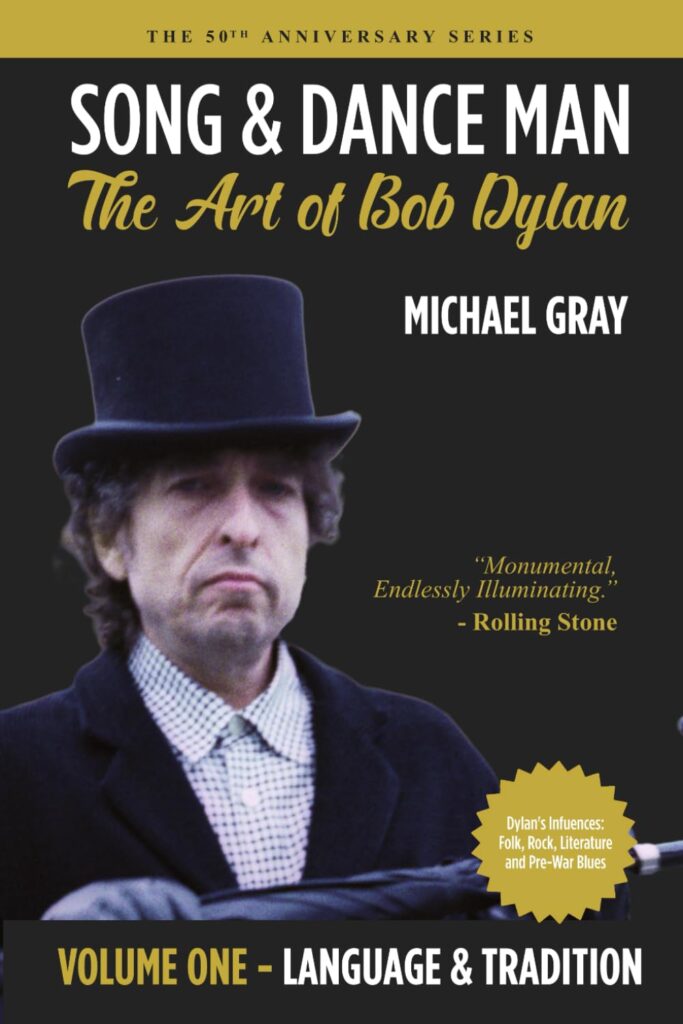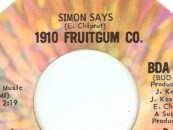 British writer Michael Gray’s gargantuan book, Song & Dance Man: The Art of Bob Dylan, which has just been reissued in America, first appeared in the U.K. in 1972 and in the U.S. and Japan in the following year. Gray updated it in the early 1980s and again in 2000, but the book was subsequently out of print for more than a dozen years. It’s not for casual fans, but if you’re a Dylan fanatic, you’re probably going to want the new 2023 edition, which divides what had been a fat single book into three more manageably sized volumes (available to order in the U.S. here and in the U.K. here).
British writer Michael Gray’s gargantuan book, Song & Dance Man: The Art of Bob Dylan, which has just been reissued in America, first appeared in the U.K. in 1972 and in the U.S. and Japan in the following year. Gray updated it in the early 1980s and again in 2000, but the book was subsequently out of print for more than a dozen years. It’s not for casual fans, but if you’re a Dylan fanatic, you’re probably going to want the new 2023 edition, which divides what had been a fat single book into three more manageably sized volumes (available to order in the U.S. here and in the U.K. here).
The first, on “Language & Tradition,” opens with cogent summaries of Dylan’s work in the 1960s and ’70s and, says Gray, examines it “in terms of how the writing and performance operate in relation to folk music, blues, rock, and mainstream literature.” The second, subtitled “Yonder Comes Sin,” focuses on the singer’s move in the late ’70s “to born-again Christianity and beyond” while the third, subtitled “World Gone Right,” looks at his 1990s albums. Unfortunately, this reissue does not add commentary about Dylan’s considerable achievements in the current century; perhaps if these books sell well, we’ll see a fourth volume at some point.
Unlike Mark Lewisohn’s equally lengthy Beatles tome, Tune In—which not only limns the lives of the Fab Four but also the people, places and milieu that gave birth to them—Gray’s opus focuses almost entirely on his subject’s recorded output. As he says in an introduction, “This is not a biography of Bob Dylan but a critical study of his work. It doesn’t look at what he eats for breakfast but at what he writes in his songs.” It is also, notes the author, “more about Dylan’s words than his music, though it tries to take a proper account of both.”
Gray’s knowledge of his subject is encyclopedic, and he digs up all sorts of interesting connections. Dylan’s “What looks large from a distance close up ain’t never that big” (from Empire Burlesque’s “Tight Connection to My Heart”) turns out to echo a line from a 1934 Gary Cooper movie called Now and Forever, for example. Other phrases in that album, says Gray, appear to have been lifted from the films Shane, a 1953 western, and The Sandpiper, a 1965 drama.
Granted, you must be a Dylan obsessive to make your way through all three of these volumes, which together total nearly a thousand pages, especially since Gray’s prose often reads like a doctoral thesis. (On many pages, footnotes consume almost as much space as the main text.) Moreover, you need to be prepared for a bit of quirkiness from the author, who pays minimal attention to some Dylan compositions while holding a magnifying glass to others. The song “Every Grain of Sand” gets an entire 24-page chapter in Volume Two, for example, while the widely panned Under the Red Sky album is the focus of a 64-page chapter in Volume Three.
Gray is nothing if not opinionated, and you might find yourself applauding some of his comments while disagreeing vehemently with others. His take on certain recordings parallels conventional wisdom and some of his observations strike this writer as just right. But he comes down rather hard on the largely excellent Desire, for example, and claims “huge flaws” mar the justifiably popular Time Out of Mind; he also calls the MTV Unplugged album “the dreariest, most contemptible, phony, tawdry piece of product ever issued by a great artist.” That sounds like a major overstatement, and you might also take issue with his claim that Street Legal—a fine and underrated album, to be sure—is “of astonishing complexity and confidence, delivered in Dylan’s most authoritative voice.”
Of course, many Dylan fans love to wade into and debate the details, and there’s plenty of opportunity for that here, along with all sorts of fascinating trivia. Let the fun begin.
Related: Another major Dylan book arrived last fall






No Comments so far
Jump into a conversationNo Comments Yet!
You can be the one to start a conversation.